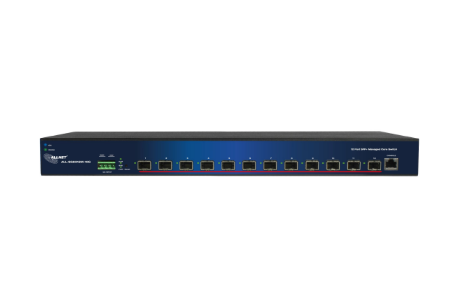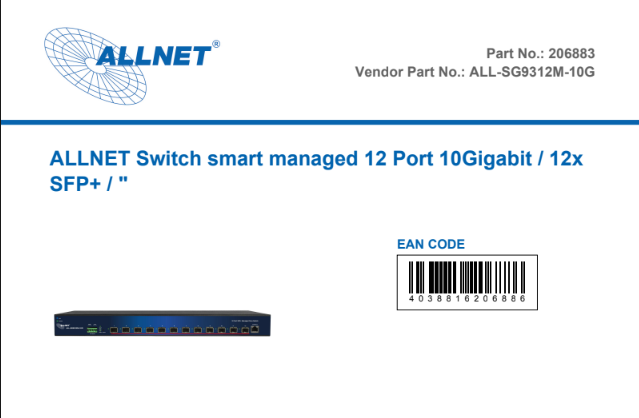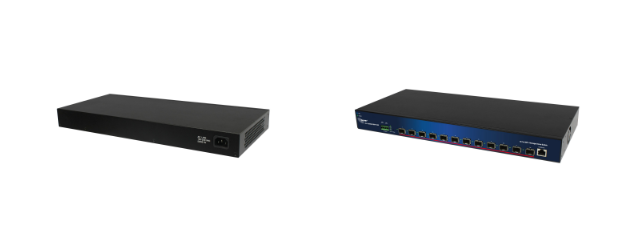10GBE SWITCH
ALL-SG9312M-10G

ALLNET Switch Managed 12 Port 10Gigabit / 12x SFP+ /
PRODUCT DESCRIPTION
- Highlights:
- Support 12*10G SFP+ ports Core-Switch
- Support Web UI for configuration
- Support Console port with CLI command
- Redundant 12VDC Power-INPUT
- Description: This switch is a 12-port 10G SFP+ L2 Switch. The switch provides exceptionally smart Web management features, such as VLAN, QoS, RSTP, IGMP Snooping, LACP, IEEE802.1X, Storm Control, etc. The switch is standard 19” rack-mount design to fit into the rack environment. With these features, the switch is a superb choice for medium or large network environments to strengthen its network connection and efficiency.

ALLNET Switch smart managed 12 Port 10Gigabit / 12x SFP+ / "ALL-SG9312M-10G" SFP Switch
- Highlights:
- Support 12*10G SFP+ ports Core-Switch
- Support Web UI for configuration
- Support Console port with CLI command
- Redundant 12VDC Power-INPUT
- Description: This switch is a 12-port 10G SFP+ L2 Switch. The switch provides exceptionally smart Web management features, such as VLAN, QoS, RSTP, IGMP Snooping, LACP, IEEE802.1X, Storm Control, etc. The switch is standard 19” rack-mount design to fit into the rack environment. With these features, the switch is a superb choice for medium or large network environments to strengthen its network connection and efficiency.
specifications
Technical Details: Hardware Specs
Additional Images

Accessories
- 27947 ALLNET ALL4750 / Switch module SFP (mini Gbic), 1000Mbit, SX
- 128033 ALLNET Switch Modul ALL4750-INDU SFP(Mini-GBIC), 1000Mbit MM
- 59426 ALLNET ALL4751 / Switch module, GBIC mini module, 1000Mbit,
- 128034 ALLNET Switch Module ALL4751-INDU SFP(Mini-GBIC), 1000Mbit,
- 114334 ALLNET Switch Modul ALL4752 SFP(mini Gbic), 1000Mbit, LHX/LC
- 166757 ALLNET Switch Modul ALL4752-INDU SFP(Mini-GBIC), 1000Mbit, LX/LC, 20KM, Industrial, -40/+85 Grad,
- 59391 ALLNET ALL4753 / Switch module GBIC Mini module, 1000Mbit, L
- 59393 ALLNET ALL4755 / Switch module SFP (mini Gbic), 1000Mbit, ZX
- 143548 ALLNET Switch Module ALL4756 SFP(Mini-GBIC), 1000Mbit, ZX/LC
- 101189 ALLNET ALL4757 / Switch module SFP+ (mini Gbic), 10Gbit, SR/
- 149613 ALLNET Switch Module ALL4757-INDU SFP+(Mini-GBIC), 10Gbit
- 101190 ALLNET ALL4758 / Switch module SFP+ (mini Gbic), 10Gbit, LR/
- 149616 ALLNET Switch Module ALL4758-INDU SFP+(Mini-GBIC), 10Gbit
- 128848 ALLNET Switch Module ALL4760 SFP+(Mini-GBIC), 10Gbit
- 136828 ALLNET Switch Module ALL4761 SFP(Mini-GBIC), 1000Mbit
- 193149 ALLNET Switch Modul ALL4761-INDU SFP(Mini-GBIC), 1000Mbit, WDM(Bidi)/LC, Tx1310nm/Rx1490nm, 9u, 20Km, Industrial -40/+85 Grad,
- 136829 ALLNET Switch Module ALL4762 SFP(Mini-GBIC), 1000Mbit
- 193150 ALLNET Switch Modul ALL4762-INDU SFP(Mini-GBIC), 1000Mbit, WDM(Bidi)/LC, Tx1490nm/Rx1310nm, 9u, 20Km, Industrial -40/+85 Grad,
- 139776 ALLNET Switch Module ALL4763 SFP+(Mini-GBIC), 10Gbit
- 139777 ALLNET Switch Module ALL4764 SFP+(Mini-GBIC), 10Gbit
- 140675 ALLNET Switch Module ALL4765 SFP(Mini-GBIC), 1000Mbit
- 146282 ALLNET Switch Module ALL4767 SFP+(Mini-GBIC), 10Gbit
- 191685 ALLNET Switch Modul ALL4768 SFP+(Mini-GBIC), 10Gbit Singlemode, LR/LC, bis 40Km
- 191686 ALLNET Switch Modul ALL4769 SFP+(Mini-GBIC), 10Gbit Singlemode, LR/LC, bis 80Km
- 194705 ALLNET Switch Modul ALL4794 SFP(Mini-GBIC), 100Mbit, LX/LC, 10Km, single Mode,
- 194706 ALLNET Switch Modul ALL4794-INDU SFP(Mini-GBIC), 100Mbit, LX/LC, 10Km, singlemode, Industrial -40/+85 Grad,
- 141255 Netzkabel 230V Schutzkontakt CEE7(Stecker)->Kaltgeräte IEC-C13(Buchse), 1m,Black IEC Lock
- 141254 Netzkabel 230V Schutzkontakt CEE7(Stecker)->Kaltgeräte IEC-C13(Buchse), 2m,Black IEC Lock
- 141256 Netzkabel 230V Schutzkontakt CEE7(Stecker)->Kaltgeräte IEC-C13(Buchse), 3m,Black IEC Lock
Request a Quote
Learn More From
Frequently Asked Questions
Multimode fiber commonly comes in 50/125 μm or 62.5/125 μm core/cladding dimensions, with bandwidth capacities ranging from 200 MHz to 2 GHz, depending on the grade. Multimode systems typically support transmission distances of up to 5 km, making them suitable for short- to medium-range applications.
In contrast, singlemode fiber—usually 9–10/125 μm—offers significantly lower attenuation and effectively unlimited bandwidth, supporting links over 150 to 200 km, especially when paired with optical amplifiers and advanced transceivers.
While singlemode fiber is less expensive per meter, its associated transceivers and equipment tend to cost more than their multimode counterparts. That said, singlemode devices are generally compatible with both singlemode and multimode fiber, whereas multimode equipment works only with multimode fiber.
Let me know if you’d like this turned into a quick-reference table or visual comparison—it’d make a solid inclusion for a fiber deployment guide.
The link budget is the difference between the transmitter’s output power and the receiver’s sensitivity. This budget must account for all signal losses along the path, including:
- Fiber attenuation due to the transmission medium
- Connector losses, such as those at patch panels or equipment interfaces
- Splice losses from mechanical or fusion joints
- Link margin, which provides a buffer for unforeseen variations
The link margin typically ranges from 2–3 dB in tightly controlled environments to up to 10 dB in more variable conditions. It is designed to accommodate:
- Component aging (e.g., light sources may degrade and lose up to 3 dB over time)
- Temperature variations affecting transmitter output or receiver sensitivity (up to 3 dB may be needed for thermal fluctuations)
- Physical cable damage and repair-induced losses (usually minor, but more relevant in harsh or industrial settings)
Always design your system for worst-case scenarios to ensure reliability. However, don’t overlook the best-case condition either—some optical receivers may exhibit erratic behavior if the incoming signal is too strong.
First, verify the optical signal strength along the link. Use an optical power meter to measure the received power at the fiber’s end point. Typical transmit levels range from –8 dBm to –15 dBm, while the receiver sensitivity is around –31 dBm, giving you a link budget of approximately 16 dB. This margin supports transmission distances of up to 10 km on singlemode fiber and about 3–5 km on multimode fiber.
If the measured power falls below the receiver sensitivity, there’s a strong likelihood of issues with the installed fiber. Ideally, initial OTDR readings should have flagged such faults.
If not, inspect the patch cords currently in use for possible defects or misalignment. A frequent oversight is the use of mismatched patch cords.
Multimode fiber types are classified by the ISO/IEC 11801 standard into five main categories: OM1, OM2, OM3, OM4, and OM5. Each type differs in core size, bandwidth, supported data rates, and maximum transmission distances. Here’s a quick breakdown:

- OM3 and OM4 are laser-optimized and widely used in modern data centers.
- OM5 supports shortwave wavelength division multiplexing (SWDM), enabling multiple wavelengths over a single fiber for higher capacity.
- All OM types are backward compatible in terms of connectors, but mixing core sizes (e.g., OM1 with OM3) can cause performance issues.
